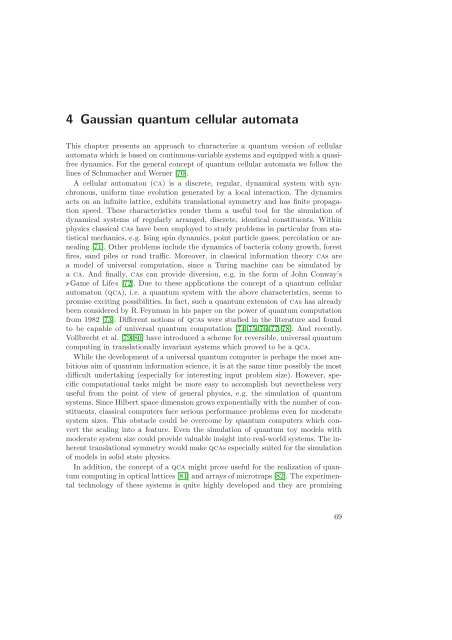Quantum Information Theory with Gaussian Systems
Quantum Information Theory with Gaussian Systems
Quantum Information Theory with Gaussian Systems
You also want an ePaper? Increase the reach of your titles
YUMPU automatically turns print PDFs into web optimized ePapers that Google loves.
4 <strong>Gaussian</strong> quantum cellular automata<br />
This chapter presents an approach to characterize a quantum version of cellular<br />
automata which is based on continuous-variable systems and equipped <strong>with</strong> a quasifree<br />
dynamics. For the general concept of quantum cellular automata we follow the<br />
lines of Schumacher and Werner [70].<br />
A cellular automaton (ca) is a discrete, regular, dynamical system <strong>with</strong> synchronous,<br />
uniform time evolution generated by a local interaction. The dynamics<br />
acts on an infinite lattice, exhibits translational symmetry and has finite propagation<br />
speed. These characteristics render them a useful tool for the simulation of<br />
dynamical systems of regularly arranged, discrete, identical constituents. Within<br />
physics classical cas have been employed to study problems in particular from statistical<br />
mechanics, e.g. Ising spin dynamics, point particle gases, percolation or annealing<br />
[71]. Other problems include the dynamics of bacteria colony growth, forest<br />
fires, sand piles or road traffic. Moreover, in classical information theory cas are<br />
a model of universal computation, since a Turing machine can be simulated by<br />
a ca. And finally, cas can provide diversion, e.g. in the form of John Conway’s<br />
Game of Life[72]. Due to these applications the concept of a quantum cellular<br />
automaton (qca), i.e. a quantum system <strong>with</strong> the above characteristics, seems to<br />
promise exciting possibilities. In fact, such a quantum extension of cas has already<br />
been considered by R. Feynman in his paper on the power of quantum computation<br />
from 1982 [73]. Different notions of qcas were studied in the literature and found<br />
to be capable of universal quantum computation [74, 75, 76, 77, 78]. And recently,<br />
Vollbrecht et al. [79,80] have introduced a scheme for reversible, universal quantum<br />
computing in translationally invariant systems which proved to be a qca.<br />
While the development of a universal quantum computer is perhaps the most ambitious<br />
aim of quantum information science, it is at the same time possibly the most<br />
difficult undertaking (especially for interesting input problem size). However, specific<br />
computational tasks might be more easy to accomplish but nevertheless very<br />
useful from the point of view of general physics, e.g. the simulation of quantum<br />
systems. Since Hilbert space dimension grows exponentially <strong>with</strong> the number of constituents,<br />
classical computers face serious performance problems even for moderate<br />
system sizes. This obstacle could be overcome by quantum computers which convert<br />
the scaling into a feature. Even the simulation of quantum toy models <strong>with</strong><br />
moderate system size could provide valuable insight into real-world systems. The inherent<br />
translational symmetry would make qcas especially suited for the simulation<br />
of models in solid state physics.<br />
In addition, the concept of a qca might prove useful for the realization of quantum<br />
computing in optical lattices [81] and arrays of microtraps [82]. The experimental<br />
technology of these systems is quite highly developed and they are promising<br />
69
















